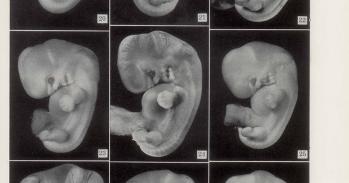
A new online exhibition explores the visual culture of embryology as part of a research initiative on the history of reproduction.
A new online exhibition explores the visual culture of embryology as part of a research initiative on the history of reproduction.
Reflection on generation goes back to antiquity, but the term ‘reproduction’ gained wide currency only during the age of revolutions around 1800. ‘Generation’ was the all-encompassing process by which new creatures came into being and in which the human acquisition of a rational soul was the crucial event. ‘Reproduction’ was more narrowly framed, and soon became a topic of scientific research, a target of medical and agricultural intervention, and a project for pressure groups and states seeking to improve the quantity and quality of populations. In the modern era, reproduction has been made increasingly independent of sex.
A group of medical historians in the Department of History and Philosophy of Science (HPS) is studying these changes. Under the theme ‘From Generation to Reproduction’, and funded by a Wellcome Trust Enhancement Award, Drs Nick Hopwood and Lauren Kassell and Professors John Forrester, Jim Secord and Nick Jardine are investigating how our world of reproductive practices, controversies and, not least, images was made.
From generation to reproduction
Since 2004, the Enhancement Award has enabled the researchers to build strength in the history of reproduction through studentships, research leave and events. Seminars, workshops and conferences have generated lively local, national and international conversations, and created new cross-disciplinary initiatives such as the Cambridge Interdisciplinary Reproduction Forum, a graduate/faculty research group at the Centre for Research in the Arts, Social Sciences and Humanities (CRASSH).
Current work covers topics as diverse as consultations about childbearing in astrological casebooks, controversies over Darwinism, the hospitalisation of childbirth in the 20th century and the advent of in vitro fertilisation. The history of embryo and fetus, and especially their visualisation, is a major focus and the subject of the main outreach activity of the award – ‘Making Visible Embryos’, an online exhibition by Drs Tatjana Buklijas and Nick Hopwood.
An online exhibition
Images of human embryos are everywhere today: in newspapers, clinics, classrooms, laboratories, baby albums and on the internet. Debates about abortion, evolution, assisted conception and stem cells have made these representations controversial, but they are also fairly routine, and we tend to take them for granted. Yet as recently as 250 years ago human development was nowhere to be seen. How were embryo images made to represent some of the most potent biomedical objects, and subjects, of our time?
The story begins with a sketch of the variety of views of pregnancy and the unborn before developing embryos were first drawn at the end of the 18th century. We then see how, during the 1800s, medicine and biology exploited technical innovations to produce pictures and models that communicated new attitudes to childbirth, evolution and reproduction. In the 20th century, these became the dominant representations of pregnancy and prominent symbols of biomedical hope and fear.
The exhibition contextualises such icons as the German Darwinist Ernst Haeckel’s allegedly forged illustrations and the Swedish photographer Lennart Nilsson’s ‘Drama of Life Before Birth’ on a 1965 cover of Life magazine. It also interprets over 120 now little-known drawings, engravings, woodcuts, oil paintings, frescos, wax models, X-rays and ultrasound scans. By depicting imaging technologies and people engaged in image production (see picture), the web pages emphasise the work of making visible embryos. Wherever we stand in today’s debates, it should enrich our understanding of embryos, and of reproduction more generally, to explore how these icons have been made.
For more information, please contact the author Dr Nick Hopwood (ndh12@cam.ac.uk) at HPS.
‘Making Visible Embryos’ is at www.hps.cam.ac.uk/visibleembryos and the HPS History of Medicine programme is at www.hps.cam.ac.uk/medicine
This work is licensed under a Creative Commons Licence. If you use this content on your site please link back to this page.





